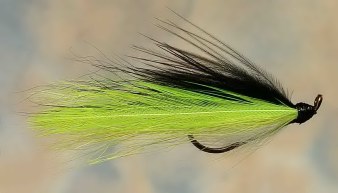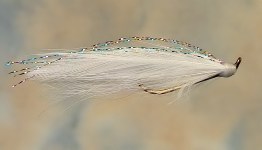Invicta Flies - Brushpile
The Brushpile was designed for offering to crappie and other panfish which hang out in tight brushy cover such as submerged/fallen trees (brushpiles). Where other small flies would easily get caught on limbs and twigs, this fly slides right through. Using this style of hook, rather than a straight eye, allows for good vertical movement. That, combined with the light weight, lets you work the fly dead in the middle of the brush, working it around, up and down, the tangles of branches. A non-slip loop knot helps enhance the movement.

Hook: Mustad 9671, #8
Thread: Uni-Thread 6/0, black
Belly: white rabbit fur
Body: bucktail, fluorescent yellow & black
Back: black marabou
Sides: chartreuse saddle hackles
Tying Instructions:
1) Place the hook in the vise upside down, hook point up, with the shank rising at about a 45 degree angle.
2) Secure the thread to the shank just behind the eye and wrap back about one and a half hook eye widths. All materials will be tied on in this short area.
3) Clip a small bunch of rabbit fur from the hide, aligning the tips somewhat. Measure for length against the hook. We want the tips of the fine underfur to extend just to the hook point. Allow a hook eye width for tying in, and trim away the rest. Hold the clump against the shank and take a couple loose wraps, then pull down to tighten. Hold the clump up and taught as you cover the tied-in portion with tight thread wraps. Bring the thread to the back of the tie-in area, then wind forward again for two thread widths.
4) From the fluorescent bucktail, trim a bundle 3/4 matchstick in diameter. Use the finer hairs near the tip of the tail.Even the tips as much as possible. Use the hook to measure for length- the bucktail should extend beyond the furthest edge of the bend for a length equal to the entire hook. Trim the butts now, allowing ample space for tying in, but so that none have to be trimmed afterward. Hold the clump on the shank at the tie in area at an angle so the tips are up at 45 degrees from the center line. Take two loose turns, then pull down to tighten. Take three more tight turns of thread in front of the first two, then lift the bucktail and take two turns of thread underneath and tight agianst it (this helps lift the bundle). Cover the remanider of the butts with the thread.
5) Add a clump of black bucktail, about half a thick, directly on top of the first. Make the length about a hook eye width longer than the first clump. Use the same method of tying in, and cover all butts with the thread, Cement the thread wraps and all to soak in.
6) From a black marabou feather, trim a section of fibers an inch long, keeping the tips aligned. Wetting the fibers a bit helps keep them under control. Gather the fibers into a bundle and tie in directly on top of the bucktail with three loose turns of thread. The tips should extend to half the length of the bucktail (just beyond the hook bend). Grasp the tips with one hand, the butts with the other, and pull up to position all the fibers on top. Pull down on the thread to tighten, pinching the bundle to hold it in place, then take a couple more tight turns of thread. Lift up the butts and trim as close to the thread wraps as possible. Cover any remainder with the thread.
7) Prepare the saddle hackles. There will be two on each side, so place for together and align the tips. Measure so the tips will extend to the tip of the tail, allowing a little less than a hook eye width for tying in. Trim away the butts. Turn the fly over and tie two of the saddles on the far side. This can be a little tricky, as the saddles will want to twist. To help, leave all the fibers at the butt end (do not trim from tie-in area) and hold the feathers together so the saddle that is on the outside closer to what will be the top of the fly. Use the initial thread wrap to position the saddle, then continue with tight turns of thread in front of the first, all the while holding the feathers in position. If they are flat against the side, cement the thread wraps. Turn the fly over and repeat for tying the saddles in on the near side.
8) If you want to add some flash to this fly, tie it now as a topping. Five strands of Krystal Flash is sufficient. Round out the head with the tying thread, then whip finish. Apply a generous coat of cement.
For crappie, try bright colors like the version shown above, or shiner/minnow immitating colors such as that shown at right. This version uses white and gray bucktail, white saddles, and Rainbow Flashabou Accent
|
 |